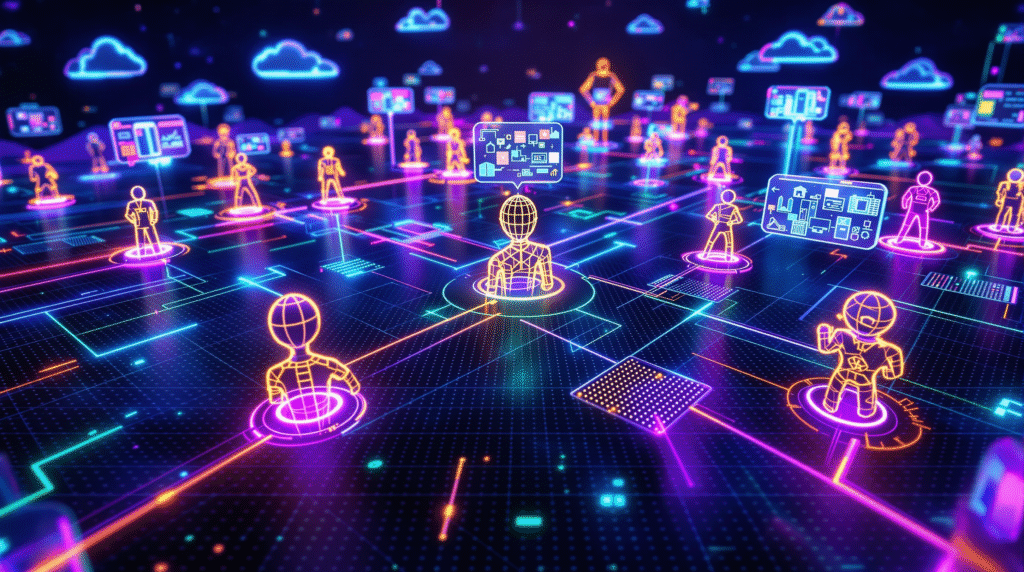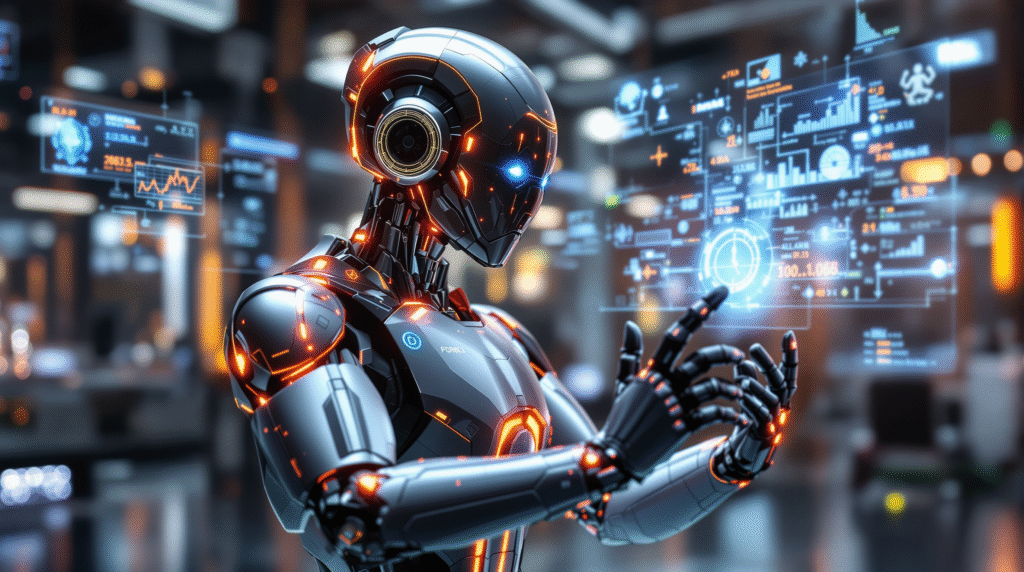Introduction: The Intersection of AI Agents and Distributed Systems
AI Agents Overview
AI agents are autonomous software entities capable of perceiving their environment, making decisions, and acting to achieve specific goals. They can range from simple reactive agents that respond to stimuli, to complex deliberative agents that plan and learn over time. These agents are designed to operate independently or collaboratively, adapting to dynamic conditions.
Basics of Distributed Systems
Distributed systems consist of multiple interconnected computers or nodes that work together to perform tasks. Unlike centralized systems, distributed architectures offer scalability, fault tolerance, and resource sharing by distributing workload across many machines. Key challenges include managing communication, synchronization, and consistency among nodes.
Why Combine AI Agents with Distributed Architectures?
Integrating AI agents into distributed systems brings several advantages. Distributed AI agents can operate concurrently across different nodes, enabling parallel processing and faster decision-making. This setup enhances system robustness, as failure in one node does not cripple the entire system. Moreover, distributed AI agents can collaborate to solve complex problems that are beyond the capacity of a single agent.
For example, in Internet of Things (IoT) networks, AI agents deployed on edge devices can process data locally and coordinate with other agents to optimize resource usage and respond to real-time events. In cloud environments, distributed AI agents can scale elastically to handle varying workloads, improving performance and cost-efficiency.
Conclusion
The convergence of AI agents and distributed systems represents a promising frontier in software development. By combining autonomous intelligence with scalable architectures, developers can create applications that are not only smart but also resilient and efficient. This synergy is driving innovation across industries, from smart cities to autonomous vehicles, and will continue to shape the future of technology.
Fundamentals of AI Agents
Definition and Characteristics
AI agents are software entities designed to autonomously perceive their environment, process information, and take actions to achieve specific objectives. They exhibit characteristics such as autonomy, reactivity, proactiveness, and social ability. Autonomy allows agents to operate without constant human intervention, while reactivity enables them to respond promptly to environmental changes. Proactiveness means agents can take initiative to fulfill goals, and social ability allows interaction with other agents or humans.
Types of AI Agents
There are several types of AI agents, each with different levels of complexity and capabilities:
Reactive Agents: These agents respond directly to stimuli from their environment without internal state or memory. They are simple and fast but limited in planning abilities.
Deliberative Agents: Equipped with internal models and reasoning capabilities, these agents plan actions based on goals and knowledge about the environment.
Hybrid Agents: Combine reactive and deliberative approaches to balance responsiveness and planning.
Learning Agents: Capable of improving their performance over time by learning from experience using techniques like machine learning.
Autonomy and Learning Capabilities
Autonomy is a core feature that distinguishes AI agents from traditional software. Autonomous agents can make decisions independently, adapting to new situations without explicit programming for every scenario. Learning capabilities enhance this autonomy by enabling agents to improve through data-driven methods, such as supervised learning, reinforcement learning, or unsupervised learning. This adaptability is crucial for operating in dynamic and uncertain environments.
Encapsulation as Microservices
In modern software architectures, AI agents can be encapsulated as microservices. This means each agent runs as an independent service with well-defined interfaces, enabling modularity, scalability, and easier maintenance. Microservice-based AI agents can be deployed, updated, and scaled independently, fitting well into distributed systems.
Conclusion
Understanding the fundamentals of AI agents is essential for designing intelligent systems that can operate effectively in distributed environments. Their autonomy, diverse types, and learning abilities make them versatile tools for solving complex problems across various domains.
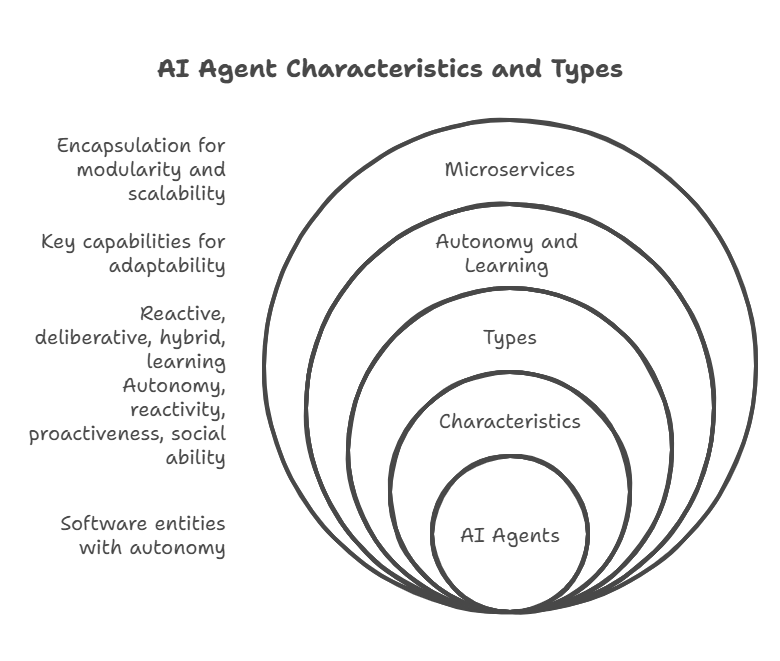
Key Concepts in Distributed Systems
Distributed Computing Principles
Distributed systems consist of multiple independent computers (nodes) that work together to achieve a common goal. These systems aim to provide scalability, fault tolerance, and resource sharing by distributing tasks across nodes. Key principles include transparency (hiding the complexity of distribution from users), concurrency (multiple processes running simultaneously), and openness (standardized interfaces for interoperability).
Communication and Coordination
Effective communication is fundamental in distributed systems. Nodes exchange messages to coordinate actions, share data, and synchronize states. Communication can be synchronous (blocking) or asynchronous (non-blocking), and protocols must handle message delivery, ordering, and reliability. Coordination mechanisms, such as consensus algorithms and distributed locks, ensure consistency and prevent conflicts.
Fault Tolerance and Scalability
Distributed systems must handle failures gracefully to maintain availability. Fault tolerance involves detecting failures, recovering from them, and continuing operation without data loss or corruption. Techniques include replication, checkpointing, and failover strategies. Scalability allows the system to handle increasing workloads by adding more nodes, ensuring performance remains stable as demand grows.
Data Consistency and Synchronization
Maintaining consistent data across distributed nodes is challenging due to network delays and failures. Models like eventual consistency, strong consistency, and causal consistency define how and when updates propagate. Synchronization protocols coordinate access to shared resources, preventing race conditions and ensuring data integrity.
Security Considerations
Security in distributed systems involves protecting data and communication from unauthorized access and attacks. Measures include encryption, authentication, authorization, and intrusion detection. Ensuring secure communication channels and safeguarding sensitive information are critical for trustworthiness.
Conclusion
Grasping these key concepts is vital for designing and managing distributed systems that are reliable, efficient, and secure. These foundations enable the effective integration of AI agents within distributed architectures, leveraging their full potential.
Designing AI Agents for Distributed Environments
Architectural Patterns
Designing AI agents for distributed systems requires choosing appropriate architectural patterns that support scalability, modularity, and fault tolerance. Common patterns include client-server, peer-to-peer, and microservices architectures. Microservices are particularly popular, as they allow agents to operate as independent services that communicate via APIs, enabling flexible deployment and easy scaling.
Stateless vs. Stateful Agents
AI agents in distributed environments can be designed as stateless or stateful. Stateless agents do not retain information between interactions, simplifying scalability and fault tolerance but limiting context awareness. Stateful agents maintain internal state, enabling more complex behaviors and learning but requiring mechanisms for state synchronization and recovery in case of failures.
Handling Concurrency and Synchronization
Distributed AI agents often operate concurrently, which introduces challenges in managing shared resources and coordinating actions. Proper synchronization techniques, such as locks, semaphores, or consensus algorithms, are essential to prevent race conditions and ensure data consistency. Designing agents to minimize shared state or use eventual consistency models can improve performance and reduce complexity.
Scalability and Load Balancing
To handle varying workloads, AI agents should be designed to scale horizontally by adding more instances. Load balancing distributes tasks evenly across agents to optimize resource utilization and response times. Techniques like dynamic scaling and container orchestration (e.g., Kubernetes) help maintain system performance under changing demands.
Fault Tolerance and Recovery
Distributed environments are prone to partial failures. Designing AI agents with fault tolerance involves implementing retry mechanisms, failover strategies, and state checkpointing. Agents should detect failures promptly and recover gracefully to maintain overall system reliability.
Security Considerations
Security must be integrated into the design of distributed AI agents. This includes secure communication channels (e.g., TLS), authentication and authorization mechanisms, and protection against common attacks such as injection or denial-of-service. Ensuring data privacy and compliance with regulations is also critical.
Conclusion
Effective design of AI agents for distributed systems balances complexity, performance, and reliability. By carefully considering architecture, state management, concurrency, scalability, and security, developers can build robust agents that thrive in distributed environments.
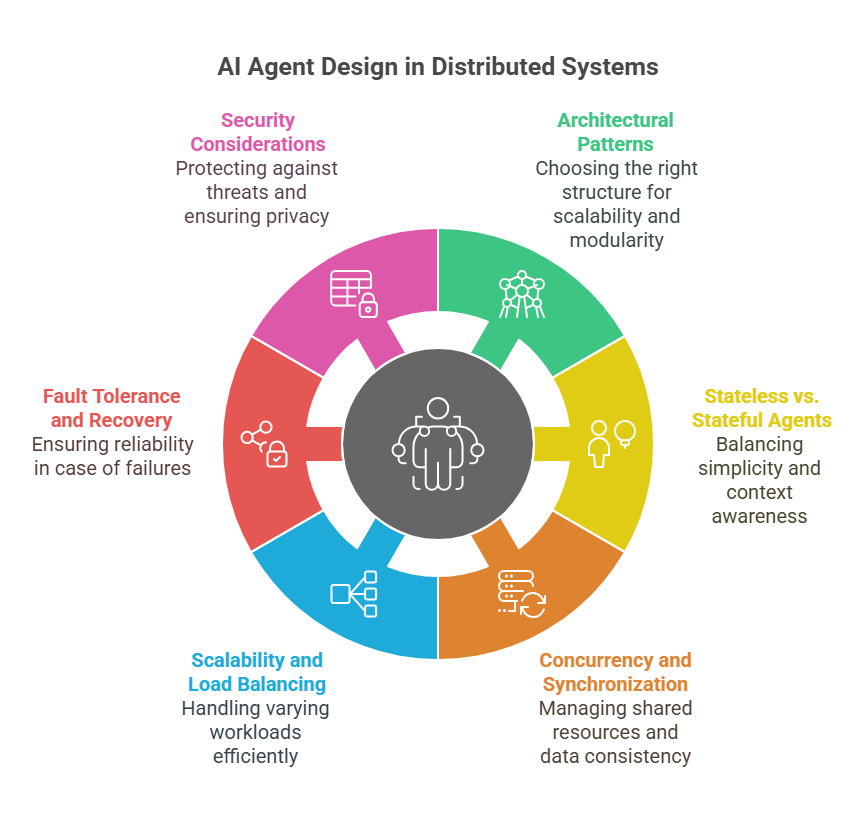
Communication Protocols for AI Agents in Distributed Systems
Message Passing and Event-Driven Communication
Communication between AI agents in distributed systems primarily relies on message passing, where agents exchange information asynchronously or synchronously. Event-driven communication allows agents to react to specific events or messages, enabling dynamic and flexible interactions. This approach supports decoupling of agents, improving scalability and fault tolerance.
Common Communication Protocols
Several protocols facilitate communication among distributed AI agents:
MQTT (Message Queuing Telemetry Transport): A lightweight publish-subscribe protocol ideal for resource-constrained devices and IoT environments.
gRPC: A high-performance, open-source RPC framework that uses HTTP/2 for efficient communication, supporting multiple languages.
REST (Representational State Transfer): A widely used protocol based on HTTP, suitable for stateless communication and easy integration with web services.
AMQP (Advanced Message Queuing Protocol): A protocol for message-oriented middleware, supporting reliable and secure messaging.
Ensuring Reliable and Secure Communication
Reliable communication requires mechanisms for message delivery guarantees, such as at-most-once, at-least-once, or exactly-once semantics. Protocols often include acknowledgments, retries, and ordering guarantees to handle network failures and delays. Security measures like encryption (TLS/SSL), authentication, and authorization protect data integrity and privacy during transmission.
Communication Patterns
Distributed AI agents use various communication patterns depending on the application:
Request-Response: One agent sends a request and waits for a response, suitable for synchronous interactions.
Publish-Subscribe: Agents publish messages to topics, and interested agents subscribe to receive them, enabling decoupled and scalable communication.
Peer-to-Peer: Agents communicate directly without intermediaries, useful for decentralized systems.
Frameworks Supporting Agent Communication
Frameworks like SPADE (Smart Python Agent Development Environment) provide built-in support for agent communication, including message handling, protocols, and lifecycle management. These tools simplify the development of complex multi-agent systems by abstracting communication details.
Conclusion
Effective communication protocols are vital for coordinating AI agents in distributed systems. Choosing the right protocol and pattern ensures reliable, secure, and efficient interactions, enabling agents to collaborate and achieve collective goals in dynamic environments.
Challenges in Integrating AI Agents with Distributed Systems
Latency and Network Partitioning
Distributed systems inherently face network latency and the possibility of network partitions, where communication between nodes is temporarily lost. For AI agents, this can lead to delayed decision-making or inconsistent states. Designing agents to handle such delays gracefully, using asynchronous communication and eventual consistency models, is essential to maintain system responsiveness.
Data Consistency and Synchronization
Maintaining consistent data across distributed AI agents is challenging due to concurrent updates and network delays. Ensuring synchronization without sacrificing performance requires careful design choices, such as using consensus algorithms (e.g., Paxos, Raft) or adopting eventual consistency where strict consistency is not critical.
Security and Privacy Concerns
Distributed AI agents often handle sensitive data and communicate over potentially insecure networks. Protecting data privacy and securing communication channels against interception, tampering, or unauthorized access is critical. Implementing encryption, authentication, and access control mechanisms is necessary to safeguard the system.
Resource Management and Scalability
Efficiently managing computational resources across distributed nodes is complex. AI agents may require varying amounts of CPU, memory, or bandwidth, and uneven load distribution can lead to bottlenecks. Dynamic resource allocation and load balancing strategies help maintain scalability and performance.
Fault Detection and Recovery
Detecting failures in distributed environments is difficult due to partial failures and asynchronous communication. AI agents must be designed to detect faults promptly and recover without human intervention, using techniques like heartbeat signals, retries, and state checkpointing.
Complexity of Development and Debugging
Developing and debugging distributed AI agent systems is inherently more complex than centralized systems. Issues such as race conditions, deadlocks, and inconsistent states require sophisticated tools and methodologies for monitoring, logging, and testing.
Interoperability and Standardization
Integrating AI agents developed with different technologies or standards can be problematic. Ensuring interoperability through standardized communication protocols and data formats is crucial for building cohesive distributed systems.
Conclusion
While integrating AI agents with distributed systems offers significant benefits, it also introduces numerous challenges. Addressing these issues through thoughtful design, robust protocols, and effective tools is key to building reliable, secure, and scalable AI-driven distributed applications.
Use Cases and Applications
Multi-Agent Systems in IoT
In the Internet of Things (IoT), distributed AI agents are deployed across numerous connected devices, such as sensors, actuators, and smart appliances. These agents collaborate to monitor environments, optimize energy consumption, and automate responses to real-time events. For example, smart home systems use AI agents to adjust lighting, heating, and security based on user behavior and environmental data.
Distributed AI in Cloud and Edge Computing
Cloud platforms provide scalable infrastructure for deploying AI agents that process large volumes of data and perform complex computations. Edge computing complements this by placing AI agents closer to data sources, reducing latency and bandwidth usage. Together, distributed AI agents in cloud and edge environments enable applications like autonomous vehicles, real-time analytics, and personalized services.
Smart Cities and Infrastructure Management
AI agents distributed across urban infrastructure can manage traffic flow, monitor public safety, and optimize resource allocation. For instance, traffic management systems use AI agents to analyze sensor data and dynamically adjust traffic signals, reducing congestion and emissions.
Healthcare and Remote Monitoring
Distributed AI agents support telemedicine and remote patient monitoring by analyzing health data from wearable devices and sensors. These agents can detect anomalies, alert healthcare providers, and personalize treatment plans, improving patient outcomes and reducing hospital visits.
Financial Services and Fraud Detection
In finance, AI agents distributed across transaction networks monitor activities in real-time to detect fraudulent behavior and assess risks. Their ability to analyze patterns and collaborate enhances security and compliance.
Supply Chain and Logistics
AI agents coordinate across distributed supply chain nodes to optimize inventory management, route planning, and demand forecasting. This leads to increased efficiency, reduced costs, and improved customer satisfaction.
Real-World Examples and Case Studies
Amazon’s Robotics: AI agents control fleets of robots in warehouses, coordinating tasks to streamline order fulfillment.
Google’s Edge TPU: Distributed AI agents on edge devices accelerate machine learning inference for applications like image recognition.
Smart Grid Management: AI agents manage distributed energy resources, balancing supply and demand in real-time.
Conclusion
The versatility of AI agents in distributed systems enables transformative applications across industries. By leveraging their autonomous and collaborative capabilities, organizations can build intelligent, scalable solutions that address complex, real-world challenges.
Tools and Frameworks
Popular Libraries and Platforms for Building Distributed AI Agents
Developers have access to a rich ecosystem of tools that simplify the creation and management of AI agents in distributed environments. These libraries provide functionalities such as agent lifecycle management, communication protocols, and integration with machine learning frameworks.
Python Frameworks
Ray: A flexible, high-performance distributed execution framework that supports building scalable AI applications. Ray enables parallel and distributed computing, making it ideal for deploying AI agents across clusters.
Dask: A parallel computing library that integrates with Python’s data science stack, allowing distributed data processing and machine learning workflows.
SPADE (Smart Python Agent Development Environment): A framework specifically designed for developing multi-agent systems with built-in support for agent communication, behaviors, and protocols.
Celery: An asynchronous task queue that can be used to distribute workloads among AI agents, facilitating scalable and fault-tolerant task execution.
Deployment and Orchestration Tools
Kubernetes: An open-source container orchestration platform that automates deployment, scaling, and management of containerized AI agents, ensuring high availability and resource efficiency.
Docker: Enables containerization of AI agents, providing consistent environments for development, testing, and production deployment.
Apache Kafka: A distributed event streaming platform that supports real-time data pipelines and messaging between AI agents.
Machine Learning Integration
Many frameworks integrate seamlessly with popular machine learning libraries such as TensorFlow, PyTorch, and Scikit-learn, allowing AI agents to incorporate advanced learning and inference capabilities.
Monitoring and Logging Tools
Prometheus: For monitoring system metrics and agent performance in distributed environments.
ELK Stack (Elasticsearch, Logstash, Kibana): For centralized logging, analysis, and visualization of agent activities and system events.
Conclusion
Choosing the right tools and frameworks is crucial for efficiently building, deploying, and managing AI agents in distributed systems. Python’s rich ecosystem, combined with containerization and orchestration technologies, empowers developers to create scalable, resilient, and maintainable AI-driven applications.
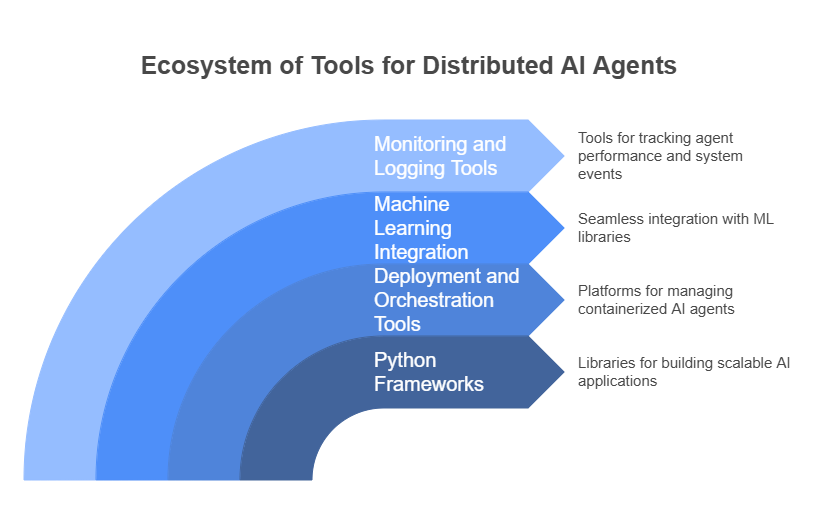
Best Practices and Design Patterns
Modular and Decoupled Architecture
Design AI agents as independent, loosely coupled components or microservices. This modularity facilitates easier maintenance, testing, and scalability. Each agent should have a clear responsibility and well-defined interfaces for communication.
Use of Standard Communication Protocols
Adopt established protocols such as REST, gRPC, or message brokers (e.g., RabbitMQ, Kafka) for agent communication. For multi-agent systems, consider agent-specific protocols like FIPA-ACL to ensure interoperability and clarity.
Event-Driven and Asynchronous Design
Implement event-driven architectures where agents react to events or messages asynchronously. This approach improves responsiveness and scalability, allowing agents to operate independently without blocking.
State Management and Statelessness
Where possible, design agents to be stateless to simplify scaling and fault tolerance. When state is necessary, use external storage solutions (databases, distributed caches) to persist state reliably.
Fault Tolerance and Graceful Degradation
Incorporate retry mechanisms, circuit breakers, and fallback strategies to handle failures gracefully. Agents should be designed to recover from errors without compromising the entire system.
Security Best Practices
Ensure secure communication using encryption (TLS), authentication, and authorization mechanisms. Protect sensitive data and validate inputs to prevent attacks such as injection or spoofing.
Logging and Monitoring
Implement comprehensive logging and monitoring to track agent behavior, performance, and errors. Use centralized logging systems and monitoring dashboards to facilitate debugging and system health checks.
Design Patterns for AI Agents
Observer Pattern: For agents to subscribe and react to events or state changes in other agents or systems.
Mediator Pattern: To manage complex communication and coordination between multiple agents.
Strategy Pattern: To allow agents to switch between different algorithms or behaviors dynamically.
Command Pattern: For encapsulating requests as objects, enabling queuing, logging, and undo functionality.
Testing and Validation
Develop unit, integration, and system tests for agents. Use simulation environments to validate multi-agent interactions and behaviors before deployment.
Documentation and Collaboration
Maintain clear documentation of agent responsibilities, interfaces, and protocols. Foster collaboration between developers, data scientists, and stakeholders to align goals and ensure smooth integration.
Future Trends and Research Directions
Advances in Distributed AI Agent Architectures
The architecture of distributed AI agents is evolving rapidly. Emerging designs focus on greater decentralization, improved scalability, and enhanced adaptability. Techniques such as federated learning allow agents to collaboratively train models without sharing raw data, preserving privacy while improving performance. Additionally, edge AI agents are becoming more capable, enabling real-time decision-making closer to data sources.
Integration with Blockchain and Decentralized Technologies
Blockchain technology offers promising solutions for distributed AI agents by providing secure, transparent, and tamper-proof data sharing and coordination. Smart contracts can automate agent interactions and enforce agreements without centralized control. Decentralized identity and reputation systems help establish trust among agents in open environments, which is crucial for multi-agent collaboration and competition.
Emerging Standards and Protocols
To ensure interoperability and seamless communication among diverse AI agents, new standards and protocols are being developed. Efforts by organizations like IEEE and FIPA aim to standardize agent communication languages, interaction protocols, and security frameworks. Adoption of these standards will facilitate integration across platforms and industries, accelerating the deployment of distributed AI systems.
Explainability and Ethical AI in Distributed Systems
As AI agents become more autonomous and distributed, ensuring transparency and ethical behavior is critical. Research is focusing on explainable AI (XAI) methods tailored for multi-agent environments, enabling stakeholders to understand agent decisions and interactions. Ethical frameworks are also being developed to guide agent behavior, especially in sensitive applications like healthcare, finance, and autonomous vehicles.
Self-Adaptive and Self-Healing Systems
Future distributed AI agents will increasingly incorporate self-adaptation and self-healing capabilities. These systems can detect anomalies, recover from failures, and optimize their performance autonomously. Such resilience is vital for large-scale deployments where manual intervention is impractical.
Cross-Domain and Cross-Platform Collaboration
Research is exploring how AI agents can operate seamlessly across different domains and platforms, sharing knowledge and resources. This includes integrating agents from IoT, cloud, edge, and mobile environments to create unified intelligent ecosystems.
Quantum Computing and AI Agents
Though still in early stages, quantum computing promises to revolutionize AI by enabling faster processing and solving complex optimization problems. Future distributed AI agents may leverage quantum algorithms to enhance learning, decision-making, and coordination.
Conclusion
Summary of Key Points
Throughout this article, we explored the synergy between AI agents and distributed systems, highlighting how their integration enables scalable, flexible, and intelligent solutions. We covered fundamental concepts of AI agents and distributed architectures, design patterns, communication protocols, challenges, and practical applications. Best practices and future trends were also discussed, emphasizing the evolving landscape of distributed AI.
The Transformative Potential of AI Agents in Distributed Systems
AI agents operating within distributed systems have the power to revolutionize industries by enabling autonomous, real-time decision-making across decentralized environments. This combination supports complex problem-solving, enhances system resilience, and fosters innovation in areas such as IoT, edge computing, and multi-agent collaboration.
Final Thoughts and Recommendations
To fully leverage the benefits of distributed AI agents, organizations should adopt modular, secure, and scalable architectures while embracing emerging standards and protocols. Collaboration between developers, data scientists, and domain experts is essential to design effective agent behaviors and ensure ethical, transparent AI deployment. Continuous monitoring, testing, and adaptation will be key to maintaining robust and trustworthy systems as this technology advances.
AI Agents: Building intelligent applications with ease
